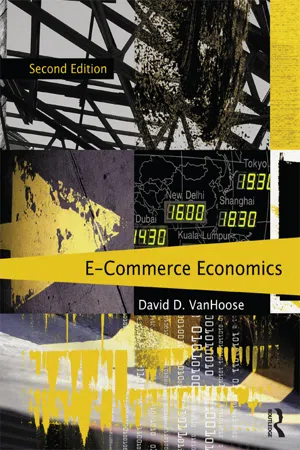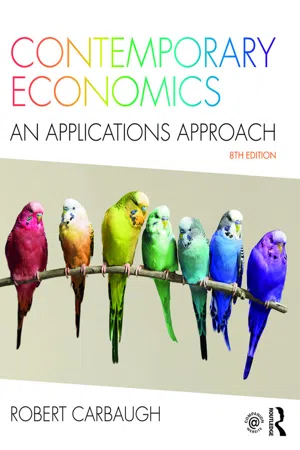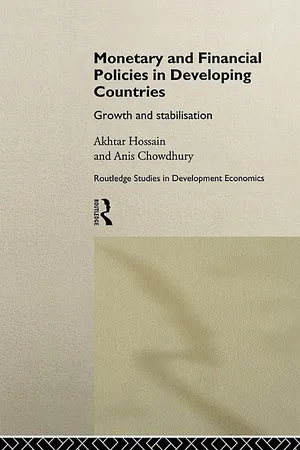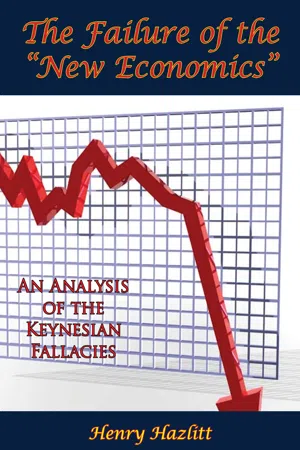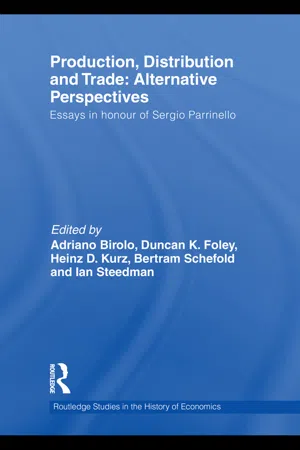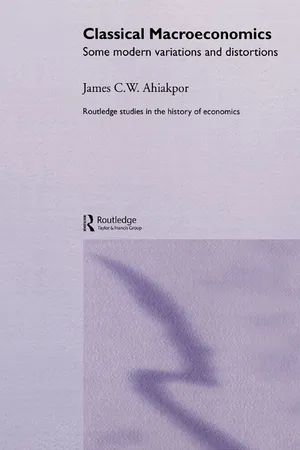Economics
Money Multiplier
The money multiplier is a concept used to measure the potential increase in the money supply through the banking system. It represents the ratio of the amount of money created by banks through lending to the amount of new reserves. By understanding the money multiplier, economists and policymakers can assess the impact of changes in the money supply on the economy.
Written by Perlego with AI-assistance
Related key terms
9 Key excerpts on "Money Multiplier"
- eBook - ePub
- David VanHoose(Author)
- 2011(Publication Date)
- Routledge(Publisher)
This means that a change in the monetary base has a multiple effect on the quantity of money. In fact, let’s define a “Money Multiplier” m M to be equal to the factor (c + 1)/(c + r), so that the final expression relating a change in the monetary base to a resulting change in the quantity of money is Δ M1 = m M × Δ MB. Money Multiplier: A number that tells how much the quantity of money responds to a change in the monetary base. The Money Multiplier, m M, is the number that gives the size of the effect of a change in the monetary base on the quantity of money. To get an idea of roughly how large this multiplier might be, let’s suppose that the desired ratio of currency holdings relative to deposits, c, equals 0.25. The value of the Money Multiplier would be m M = (c + 1)/(c + r) = (0.25 + 1)/(0.25 + 0.10) = 1.25/0.35, which is approximately equal to 3.6. Consequently, an increase in the monetary base would raise the total quantity of money by just over three and one-half times. Recall that the earlier example implied a deposit expansion multiplier that was equal to ten. Why is the Money Multiplier in this example only a third of that size? The reason is that the earlier example ignored the existence of currency. If securities dealers, businesses, and consumers desire to hold some cash in the form of currency, then each time a depository institution purchases new securities from dealers or makes new loans to businesses or consumers some funds must leave the banking system in the form of currency holdings. At every step of the deposit expansion process, fewer funds are redeposited in depository institutions, leaving fewer funds for the institutions to use for security purchases or loans. As a result, the multiplier’s value must be smaller when currency accounts for part of the quantity of money. (A regulatory loophole and information technology together have further complicated the relationship between the U.S - No longer available |Learn more
Contemporary Economics
An Applications Approach
- Robert Carbaugh(Author)
- 2016(Publication Date)
- Routledge(Publisher)
increased by $9,000 ($10,000–$1,000 = $9,000).We call the maximum amount of money that the banking system can generate with each dollar of reserves the Money Multiplier. In our example, the initial $1,000 of reserves leads to a money supply totaling $10,000; the Money Multiplier is 10.What determines the size of the Money Multiplier? The Money Multiplier is the reciprocal of the required reserve ratio, calculated as follows:Money multiplier = 1 / required reserve ratioIn our example, the required reserve ratio is 10 percent, so the Money Multiplier is 10 (1 / 0.10 = 10). If the required reserve ratio is 20 percent, the Money Multiplier is 5 (1 / 0.20 = 5).Notice that the formula tells us the maximum amount of money that the banking system can generate with each dollar of reserves. In the real world, however, the ability of the banking system to create money is smaller than the formula suggests. The main reason is that the formula assumes that all loans make their way directly into checking accounts. In reality, people may hold part of their loans as currency. The currency kept in a person’s purse or wallet or safe-deposit box remains outside the banking system and cannot be held by banks as reserves from which to make loans. The greater the currency holdings, the smaller the actual money expansion multiplier.Using M1 as our measure of the money supply, the actual Money Multiplier in the United States was about 0.8 in 2015. This is much smaller than the Money Multiplier of 5 as described in the example above. A key reason the actual Money Multiplier had such a small value in 2015 is that bank lending was relatively low.The Federal Deposit Insurance Corporation
Indeed, banks can affect the economy through their ability to create money. Therefore, there is much concern about the stability of our banking system. If many depositors lose confidence in a bank’s financial position, they may attempt to rapidly withdraw funds from the bank. One source of confidence in our banking system is the Federal Deposit Insurance Corporation. - Anis Chowdhury, Akhtar Hossain(Authors)
- 2003(Publication Date)
- Routledge(Publisher)
mm2 are greater than one and thus equations (6.11a) and (6.11b) imply that M1 and M2 exceed the central bank’s monetary liabilities (MB). The reason for money supply to exceed base money is the fractional reserves system. It allows commercial banks to keep only a fraction of their deposit liabilities as cash and reserves and to loan out the rest that creates the credit money. If banks were to keep 100 per cent of their deposit liabilities as reserves, then the value of the Money Multiplier would be equal to one. Thus, in a fractional reserves banking system, a given change in base money will lead to a multiple expansion of the money supply. The parameters that determine the Money Multiplier are the currency-demand deposits ratio (cd), the ratio of time to demand deposits (e), and the reserves-deposits ratio (rd). These parameters can change with changes in the interest rate. For example, if the interest rate on time deposits rises, people may economise on holding cash and more money may be kept in the form of time deposits. This will reduce the value of the currency-deposits ratio and increase the value of the ratio of time to demand deposits. As commercial banks may also reduce excess reserves, the reserves-deposits ratio can fall. The net result of all these effects of a rise in the interest rate is an increase in the value of the Money Multiplier. The value of the Money Multiplier is also affected by changes in the required reserves ratio (rr). If the government wants to reduce the money supply for a given level of monetary base, it can raise the required reserve ratio. This will raise rd and reduce the Money Multiplier.However, in the short run the Money Multiplier can be assumed constant. Therefore, changes in the base money alone will cause the money supply to change. From the balance sheet identity (6.5), it is evident that changes in the base money or the central bank’s liabilities originate on the asset side of the balance sheet. Credit to the government is an asset for the central bank. The government borrows from the central bank to finance its budget deficits. Budget deficits are also financed by borrowing from both non-bank public and commercial banks. Thus CG can be decomposed as- eBook - ePub
- W. Charles Sawyer, Richard L. Sprinkle(Authors)
- 2020(Publication Date)
- Routledge(Publisher)
In precise terms, the monetary base is: B = C + R A country’s money supply is equal to the monetary base multiplied by the banking Money Multiplier. The banking Money Multiplier is equal to 1 divided by the reserve requirement. In most countries, all depository institutions must keep a legal or required reserve on deposit at the central bank. This reserve requirement is an amount of funds equal to a specified percentage of its own deposits (r). For example, if the reserve requirement for banks is 10 percent, the Money Multiplier would be 10. Using these concepts, the money supply (MS) for a country becomes MS = B × 1 / r As a result, if the monetary base was $100 billion and r was.10, the money supply would be $1 trillion. 3 This relationship between the monetary base and the money supply is extremely important. When a central bank wants the money supply to change, it actually changes the monetary base or the Money Multiplier. The term printing money is literally equivalent to changing the amount of currency (C) contained in the monetary base. Printing money, however, is a relatively crude way to change the money supply within a country. In practice, governments or central banks can change the money supply by employing one of three tools. The first tool that a central bank can use to change the money supply is the discount rate. The discount rate is the interest rate that the central bank charges commercial banks for borrowing reserves. When a commercial bank borrows reserves from the central bank, the monetary base rises by an equal amount. Given the Money Multiplier, as the total reserves of the banking system increase, the money supply increases by a multiple of that amount. When a central bank lowers the discount rate, commercial banks tend to borrow more from the central bank and bank reserves rise and the money supply rises. The reverse occurs if the discount rate is increased. However, using the discount rate to control the money supply is not very precise - Henry Hazlitt(Author)
- 2016(Publication Date)
- Golden Springs Publishing(Publisher)
CHAPTER XI—“THE MULTIPLIER”
1. The Magic of It
We now come to the strange concept of “the multiplier,” about which some Keynesians make more fuss than about anything else in the Keynesian system. Indeed, a whole literature has developed around this concept alone.Let us try to see what Keynes means by the term.“In given circumstances a definite ratio, to be called the Multiplier, can be established between income and investment and, subject to certain simplifications, between the total employment and the employment directly employed on investment....This further step is an integral part of our theory of employment, since it establishes a precise relation-ship, given the propensity to consume, between aggregate employment and income and the rate of investment (p. 113).”Keynes gives credit to R. F. Kahn for first introducing the concept of the multiplier into economy theory in 1931. But Kahn’s was an “employment multiplier” whereas Keynes’s is an “investment multiplier” (p. 115).Now the average propensity to consume, the reader will recall, is “the functional relationship...between...a given level of income in terms of wage-units, and...the expenditure on consumption out of that level of income” (p. 90). So, “if Cw is the amount of consumption and Yw is income (both measured in wage-units) ∆Cw has the same sign as ∆Yw but is smaller in amount, i.e. is positive and less than unity” (p. 96).What this means, in simple and numerical terms, is that if out of three units of income, two are spent on consumption, the “propensity to consume” will be ⅔.Now in Chapter 10, and on page 115, Keynes advances to the concept of “the marginal propensity to consume.” He defines this, however, by precisely the same mathematical expression and notation as he has previously used to express what he now calls “the average propensity to consume,” viz. (p. 115). The marginal propensity to consume is the relation of the increase in consumption to the increase- eBook - ePub
- Jagdish Handa(Author)
- 2002(Publication Date)
- Routledge(Publisher)
(18) , has been refined to take account of the public’s desired ratio of time deposits to demand deposits, as well as the proportion of government deposits in commercial banks to their total demand deposits. The former ratio depends upon the interest rates on time deposits and other short-term money market instruments. The latter ratio depends mainly upon the flow of fiscal receipts and expenditures of the government.(iv) A still more elaborate money supply equation
The preceding money supply equation did not differentiate between the reserve ratios that each kind of deposit must meet. If this differentiation were made, (10) above would be modified to:where:ρD the reserve ratio for demand deposits ρT the reserve ratio against time deposits ρG the reserve ratio against government deposits Equation (19) modifies (18) to,Equations (8) , (9) , (18) and (20) are all identities. Which one is used depends upon the rules and regulations about reserve ratios, the availability of statistical data and the further behavioural assumptions that are made. In practice, theories of the money supply go beyond these identities and embed the relevant identity in a behavioural theory.10.5 A BEHAVIOURAL THEORY OF THE MONEY SUPPLY
A behavioural theory of the money supply process must take into account the behaviour of the participants in this process in order to determine the economic and non-economic determinants of the variables being studied. Such a theory studies such behaviour in terms of the main components of the preceding money supply formulae, such as the currency desired by the public, the reserves desired by the commercial banks, the amounts borrowed by them and the monetary base which the central bank wishes to provide, etc. It may, alternatively, focus on the ratios such as the currency ratio, the reserve ratio, etc. Either way can be used to build the supply function for money. Both ways represent a mixture of the above formulae approach and behavioural determinants of the main elements. On the behavioural elements, the basic analysis takes into account the sort of considerations that go into specifications of money demand functions, as discussed in Chapters 3 to 9 - eBook - ePub
- Philip Arestis, Meghnad Desai, Sheila Dow(Authors)
- 2013(Publication Date)
- Routledge(Publisher)
Once one recognises that the monetary base multiplier actually works to determine H, not M, then both a richer, and a properly realistic, analysis of money stock determination becomes necessary. One of the failings of the assumed process whereby H⇒M⇒i is that it encourages one to ignore the interaction between (bank) credit and monetary growth, and similarly to ignore the question of how banks' balance sheets come to balance (how does a commercial bank adjust to asymmetric cash flows?). With both the central bank and the commercial banks acting as interest rate setters and quantity takers, the commercial banks have to finance the demand for loans at the rates chosen by themselves. So the expansion of bank credit and of bank liabilities are intimately connected both with each other, and to the level and structure of interest rates, e.g. the pattern of interest rate differentials. Of course, bank lending (L) and bank deposits (D) can temporarily diverge, when banks finance loan extension from non-deposit liabilities (equity, or various forms of non-deposit debt liabilities, or fixed interest liabilities, e.g. from nonresidents, excluded from the monetary aggregates), or by adjustments in their marketable (liquid) assets. But such adjustment mechanisms are both limited, and usually temporary; L and D are cointegrated. For those who start by noting that central banks set interest rates, the credit expansion consequences are both intimately related to the monetary growth outcome; and the implications of credit growth and availability are just as, or more, important for consequential economic developments as the monetary outcomes. Moreover it is the demand for credit, at the interest rate chosen by the central bank, that is the prime moving force - eBook - ePub
Production, Distribution and Trade
Alternative Perspectives
- Adriano Birolo, Duncan Foley, Heinz D. Kurz, Bertram Schefold, Ian Steedman, Adriano Birolo, Duncan Foley, Heinz D. Kurz, Bertram Schefold, Ian Steedman(Authors)
- 2010(Publication Date)
- Routledge(Publisher)
In a mass production fix-price system, when demand increases, output and employment will rise instead of prices. A higher level of activity requires a higher level of active money. If the increase in demand comes from government, then the money will be available automatically. The supply of fiat money will be given by government spending, and demand will be taxes plus government borrowing. The increase in government spending will put the additional money into circulation, and it will cover the additional activity generated by the multiplier. Supply and demand for fiat money balance, so there will be no pressure from the government side for fiat money to change in value relative to real, nor for the real interest rate to change.But suppose the increase in demand comes from the private sector? Then there will have to be an increase in private sector deposits or bank notes to meet transaction needs. An increase in activity requires an increase in working capital; banks will have to make additional loans. Banks will have set their reserve levels for the “normal” level of activity; when activity rises above that level they will have to raise additional real reserves, which will drive up interest rates. When activity is below normal, banks will find themselves with excess real reserves, and interest rates will fall (Currie 1934). So we should see a schedule of interest rates and bank advances (loans creating deposits) that slopes upwards, but centers on a normal rate appropriate to a normal level of activity. (This normal rate would presumably reflect long-term expectations.) Such a schedule might be one way to understand the traditional LM curve; the “vertical” supply curve drawn in textbooks would then represent the “Money Multiplier” times the fixed level of reserves.Yet in the long term this is an untenable system. Money issued by the two sources—banks and government—is indistinguishable. Its acceptability is therefore adequately guaranteed by the fact that it is what is used to pay taxes. Convertibility is not necessary to make money acceptable; so real reserves—as opposed to clearing balances—are not needed. Yet as long as the real money system is in place, the private sector cannot meet higher demand without a rise in reserves, and is stuck with non-earning assets when demand is low. Additional reserves can be had, but only at a higher price in interest; while excess reserves act as a drag. Banks therefore have an incentive to move away from the system of real reserves - eBook - ePub
- James C.W. Ahiakpor(Author)
- 2003(Publication Date)
- Routledge(Publisher)
12 The mythology of the Keynesian multiplier
Introduction1
Among the most misleading concepts in modern macroeconomics is the Keynesian multiplier. It is also the main building block of Keynes’s (1936) aggregate demand management, and income and employment creation theory. The multiplier concept invites acceptance by building on two fundamental truths: (a) people typically consume a fraction of their income and (b) such purchases for consumption are incomes for sellers. Thus, the concept argues that consumption spending releases purchasing power to producers and thereby validates their investment plans. Saving plays no positive role in supplying the funds for investment in Keynes’s reasoning, for example, “The investment market can become congested through the shortage of cash. It can never become congested through the shortage of saving” (1937:669), and “Saving has no special efficacy as compared with consumption, in releasing cash and restoring liquidity” (1938:321).Furthermore, according to the argument, consumption spending creates a multiplier effect from some initial “autonomous” expenditure such that, in a simplified model, national income increases by a factor (k). That is, , where T is nominal income (GDP), k is the multiplier, s is the marginal propensity to save is the marginal propensity to consume, and Z is the “autonomous” expenditure, such as investment or government expenditure that does not depend on domestic savings. Keynes (1933, 1936), by his elaboration of Richard Kahn’s (1931) earlier argument, thus exalts consumption spending to a magical significance in macroeconomic analysis, contrary to the classical emphasis on savings as the fountain of investment funds for production and employment growth, as explained in Chapter 9
Index pages curate the most relevant extracts from our library of academic textbooks. They’ve been created using an in-house natural language model (NLM), each adding context and meaning to key research topics.
